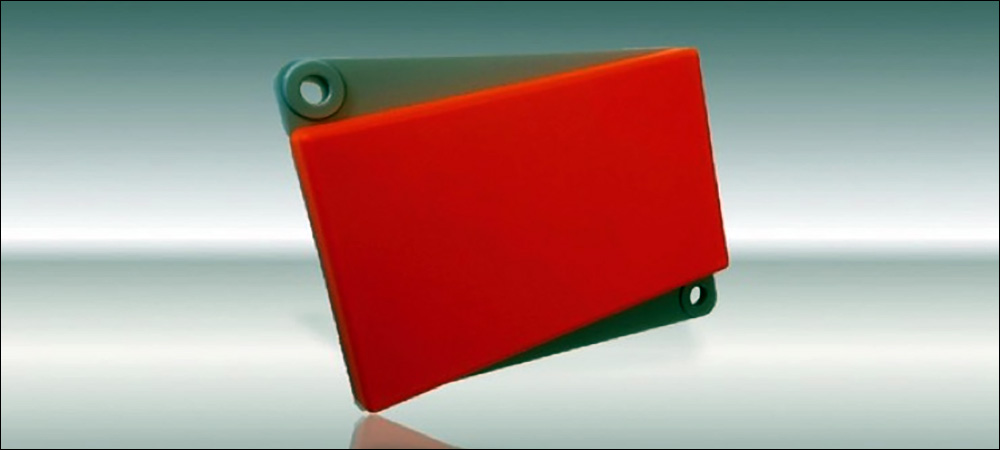Several companies are testing a new RFID-enabled datalogger to track the conditions to which food, pharmaceuticals or other temperature-sensitive products are exposed. The Maxdura Thermologger, from Smartrac (a division of Avery Dennison), is a battery-powered hard tag designed to withstand the harsh conditions of the cold supply chain, with sufficient memory to store temperature changes that could occur during a product’s transportation or storage.
The tag is available as a UHF RFID version, featuring EM Microelectronic’s EM4325 EPC Gen2 IC, while future iterations will support Near Field Communication (NFC) or Bluetooth Low Energy (BLE) formats. The company developed the new temperature-tracking tag to provide better management of food in the supply chain, among other potential applications, according to Juha Virtanen, Avery Dennison’s head of research and development. The firm plans to release the product with other sensors as well, he says, to detect conditions such as acceleration, humidity, pressure, magnetism or the presence of gas.

The Maxdura Thermologger
The tag enables the capturing of sensor data via a UHF RFID reader that may already be in use for logistical data, Virtanen explains, such as which items are passing through a dock door or have been received in a storeroom. The company designed the tag to provide sensor data storage, so that it can continue to store measurements when a tagged item is out of range of a reader, such as while it is in transit between a supplier and a logistics center or retail site. “This large UHF user memory is freely usable by the customer to store meta information,” he states, “which is very helpful for integration purposes and supports logistic applications.”
To meet the various needs of food and pharmaceutical companies and other potential users, the Maxdura Thermologger is being offered in several versions. The basic version is intended to be affordable for widespread adoption, the company reports. It has a UHF RFID tag encoded with a unique identifier, as well as the temperature sensor and processor for evaluating the measured values. That means the tag can be set to transmit only measurements that exceed preset parameters. “If a parameter is exceeded, a temperature alarm is triggered and it is possible to check in a very short time whether a measurement series was OK or not,” Virtanen says.
Because requirements vary according to the application, the tag is designed to accommodate multiple features. For instance, users can choose the logger’s memory size, the type of sensor (such as humidity or accelerometer), the precision of sensor readings and the operational frequencies for different parts of the world. That last parameter is important for global supply chains in which UHF tags may be read throughout North America, Europe and Asia, for instance.
“The target applications for the Maxdura Thermologger are cold chain applications and cold chain monitoring,” Virtanen reports. If perishable items are being tracked, for example, the device can be attached to a particular crate of fruit. Many food companies and logistics providers already employ UHF RFID to track goods as they pass through gates at a dock door, or as they are transported on an RFID-enabled forklift.
In this scenario, the existing infrastructure could be used to capture sensor measurements. If a crate of fruit has exceeded acceptable temperature levels, users would receive an alert indicating that excursion, and the users could then separate the affected crate or route it differently. In some cases, a company might want a short read range while enabling data to be collected via an NFC-enabled smartphone. Therefore, Smartrac plans to offer NFC- and BLE-based tags in the future.
Users can program the tags based on their specific sensor-reading requirements. “The sensor records the temperatures according to the programmed time interval,” Virtanen says. For instance, if a tag were programmed to capture temperature readings every 30 minutes as produce was transported from a farm to a logistics center, those readings could be collected, while only the data related to excursions could be collected and transmitted.

Juha Virtanen
Avery Dennison is selling the product directly to end users, as well as through solution integrators, Virtanen says. Most often, he notes, solutions are driven by demands from the end users. “Experience shows that the end customer is interested in the product,” he states, “and involves his systems integrator of trust for the implementation.” While the temperature-based Thermologger will initially be the only version produced, he says, “Further developments depend on customer feedback, requirements and use cases.”
According to Virtanen, the system will provide information in parts of the cold supply chain that have historically been unknown. For instance, he says, “Currently, the storage locations themselves are well monitored, but not the transfer from the storage location to the truck.” What happens on the loading ramp has not traditionally been well monitored, and that span of time, during which a product could remain unrefrigerated on a hot loading dock, could result in product damage that would go unnoticed. “Our Thermologger offers the possibility of a complete monitoring of the transported goods.”
Pressure to manage data related to shipments is increasing as consumers seek new ways to shop during the COVID-19 epidemic, Virtanen adds. With the increasing numbers of individual shipments traveling directly to consumers’ homes, he adds, “It is important to keep the cold-chain integrity intact for all of these deliveries.”
The Maxdura Thermologger has an operating temperature range of -30 degrees to +60 degrees Celsius (-22 to +140 degrees Fahrenheit). The hard tag measures 4 inches by 3 inches and is 11 millimeters (0.4 inch) thick. The IC features 3,072 bits of user memory, while a second memory is reserved for measurement data (with a maximum of 1,000 temperature measurements). Different memories sizes are available. Avery Dennison is currently taking orders for the tags in high volume. The device is the latest offering in Smartrac’s Maxdura product family.

